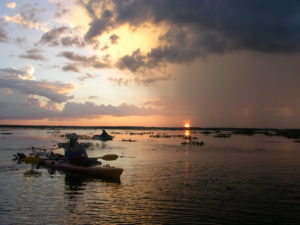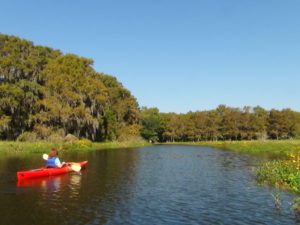Cross Creek Canoe and Kayak trips
Group size: 1 – 24 people
Trip time: 3 – 3.5hours
Skill level: Beginner – Expert. (This is an easy paddle on slow, tannin-stained waters. The open waters of the lakes can get choppy in wind, but we are never very far from the protected channel of the creek.)
Cost
Most guided tours are $50 per person. (includes boat, paddle, vest, shuttling and your guide)
Using your Own Boat – $40. (many paddlers with their own boats like to join us to learn more about the history, archaeology and natural history of these rivers).
Dates
Join a scheduled tour (see tour calendar ), or suggest one. Find a free date on the calendar and suggest the trip of your choice. If there are no conflicts, we’ll post it!
OR
Schedule a private tour. Use contact form, email us at riverguide2000@yahoo.com or call (386-454-0611)
Location
Check the River Locator Map or Click the link below for a local map and then use zoom and panning arrows to explore the area. (Note: the marker is NOT our meeting place, but a nearby landmark.
Local Map Description
Description
Cross Creek is a charming little thread of water connecting two of North Florida’s most beautiful and storied lakes, Orange and Lochloosa. On it’s brief, mile-long run, the slow flowing creek meanders lazily under a nearly complete canopy of oak, maple and moss draped cypress. On the down steam end, Orange Lake is a vast, open expanse, famous for it’s “floating islands.” In the past, it was a world-famous bass lake, but water levels and water quality issues in recent decades have reduced the fish populations greatly. Levels have come up, but there’s still a long way to go.
On the north end of the creek, Lochloosa Lake has faired a little better. The shoreline close to the creek inlet is much more accessible than that of Orange Lake, where wide marshes keep us nearly a quarter of a mile from the tree line. There are plenty of marshes on Lochloosa also, but in many places, you can paddle right up to the sandy, cypress lined shore. The lakes shore is an fantastic unbroken forest of cypress and granddaddy oaks, maples ashes and others, with the only houses seen (after leaving the Creek) being in the far distance.
 We often do this a “sunset paddle” not only to enjoy the many roosting and nesting birds that fill the trees at the end of the day, but also because of the beautiful, wide open vistas that make the perfect backdrop for the area’s beautiful sunsets. Marjorie Rawlings knew them well. “The sun at the horizon came into its full glory and the west was copper, then blood-red, blazing into an orgy of salmon and red and brass and a soft bluish yellow the color of ripe guavas. Northeast and south faded instantly to gray, timid at having usurped the flame of the sunset. Then suddenly the west dimmed, as though a bonfire charred and dimmed. There was only a bar of copper. All the sky, to every point of the compass, became a soft blue and the clouds were white powder, so that in the end it was tenderness that triumphed. I went home to sound, cool sleep.” (MKR, Cross Creek. p. 289).
We often do this a “sunset paddle” not only to enjoy the many roosting and nesting birds that fill the trees at the end of the day, but also because of the beautiful, wide open vistas that make the perfect backdrop for the area’s beautiful sunsets. Marjorie Rawlings knew them well. “The sun at the horizon came into its full glory and the west was copper, then blood-red, blazing into an orgy of salmon and red and brass and a soft bluish yellow the color of ripe guavas. Northeast and south faded instantly to gray, timid at having usurped the flame of the sunset. Then suddenly the west dimmed, as though a bonfire charred and dimmed. There was only a bar of copper. All the sky, to every point of the compass, became a soft blue and the clouds were white powder, so that in the end it was tenderness that triumphed. I went home to sound, cool sleep.” (MKR, Cross Creek. p. 289).
 Even on those days when the Big Girl (Mama Nature) offers a more dramatic end to the day, we still come away feeling far richer for the experience. On summer afternoon, the day could end more like another afternoon that Rawlings described – “The air is so still that even the restless Spanish moss hangs motionless. Although the sun is hidden the atmosphere is stifling. Then an impalpable breath stirs. The tallest palms in the east grove bend their heads, the moss in the hammock lifts as though a silent hand moved through a gray beard. There is a sibilant sound in the pecan trees, the grayness thickens, and rain marches visibly across palms and orange trees and comes in at the gate. Sometimes it is a gentle shower, sometimes a rushing flood. After it has passed, the air is as fresh and clean as April and the night will be cool for sleeping. The sun strikes through the wetness, there is likely to be a rainbow, and the palms are rosy in the evening light.” (MKR, Cross Creek. p. 285)
Even on those days when the Big Girl (Mama Nature) offers a more dramatic end to the day, we still come away feeling far richer for the experience. On summer afternoon, the day could end more like another afternoon that Rawlings described – “The air is so still that even the restless Spanish moss hangs motionless. Although the sun is hidden the atmosphere is stifling. Then an impalpable breath stirs. The tallest palms in the east grove bend their heads, the moss in the hammock lifts as though a silent hand moved through a gray beard. There is a sibilant sound in the pecan trees, the grayness thickens, and rain marches visibly across palms and orange trees and comes in at the gate. Sometimes it is a gentle shower, sometimes a rushing flood. After it has passed, the air is as fresh and clean as April and the night will be cool for sleeping. The sun strikes through the wetness, there is likely to be a rainbow, and the palms are rosy in the evening light.” (MKR, Cross Creek. p. 285)
 Regardless of how it goes, clear, cloudy or wet, the only thing that could make ending a day any better, is to go home after the trip, curl up in bed with a Rawling’s book (sunsets are best served with the book “Cross Creek”) and let her magical descriptions of the places and wildlife you’ve just experienced lull you to sleep.
Regardless of how it goes, clear, cloudy or wet, the only thing that could make ending a day any better, is to go home after the trip, curl up in bed with a Rawling’s book (sunsets are best served with the book “Cross Creek”) and let her magical descriptions of the places and wildlife you’ve just experienced lull you to sleep.
Wildlife
In addition to the wildlife mentioned in the above description, there are lots of birds. And there’s hardly a more scenic setting in north Florida to enjoy Bald eagles, osprey, several species of duck, egrets, herons and, of course those two amazing fish catchers, cormorants and anhingas. There are also many reptiles, including alligators, snakes and turtles.
This large bird of prey almost lost it’s status as U.S. national emblem because, in Ben Franklin’s words, it is a “bird of bad moral character.” This poor review was based on the birds habit of stealing fish from other birds – especially osprey. It does, however, catch plenty of its own fish as well. Eagles are long-lived birds which may have contributed to ancient beliefs in their power of rejuvenation. One myth said eagles fly to the sun then return and dive into the water. This is why they are often seen in Christian art as a symbol of rebirth. The name “bald” is derived from the old English “bhel” which meant white.
History
Prehistoric Indians found this an ideal area to live, and left plenty of evidence to attest to this fact. Near the north shore of Orange Lake, one of the oldest burial mound complexes is found near an interesting village site surrounded by earthworks. By the time Europeans began their exploration of Florida, the main village of the powerful Potano tribe was situated a short distance from the ancient earthworks.
Life changed for the Potanos in 1539, when Spanish explorer Hernando DeSoto led his expedition through this area. The chroniclers of his expedition mentioned Potano but fortunately the soldiers didn’t stay long enough to create the kind mischief which highlighted much of their journey.
 In the mid 1500’s, the Potanos withstood several raids from French and then Spanish soldiers, fighting alongside some of the Potano Indian enemies. Eventually the Potanos were forced to relocate their village to the San Felasco hammock, north west of Gainesville. Several decades later, another band of Indians moved onto the abandoned Orange Lake site. The area was now at the southern fringes of an expanding system of Christian missions being established by Spanish monks. It’s believed there was a mission briefly established here at this village, but it didn’t last long.
In the mid 1500’s, the Potanos withstood several raids from French and then Spanish soldiers, fighting alongside some of the Potano Indian enemies. Eventually the Potanos were forced to relocate their village to the San Felasco hammock, north west of Gainesville. Several decades later, another band of Indians moved onto the abandoned Orange Lake site. The area was now at the southern fringes of an expanding system of Christian missions being established by Spanish monks. It’s believed there was a mission briefly established here at this village, but it didn’t last long.
During the late 1800’s, several small steam boats conducted business on these waters – mostly carrying lumber, oranges and produce. The most active “port” seems to have been at the small community of Lochloosa on that lakes eastern shore.
The most colorful chapter in Cross Creek’s past began with the arrival, in 1928, of famed author Marjorie Kinnan Rawlings. For the next 25 years, until her death in 1953 of cerebral hemorrhage, she captured the essence of rural life in this area. Her writings brought Rawlings worldwide acclaim (and a Pulitzer Prize in 1939 for The Yearling) and inspired people around the world to dust off their atlases and search for this tiny hamlet. Today, her enchanting words still lure thousands of people every year to visit her home, now a quiet and appropriately “off-the-beaten-path” State Park with scheduled tours. (For park info, call 352-466-3672).
